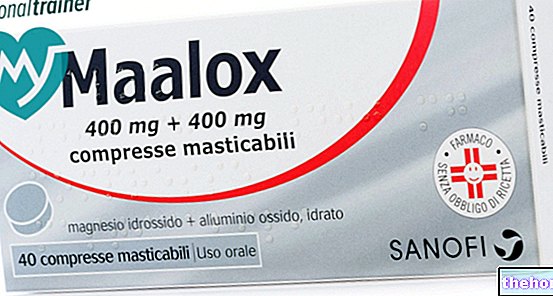Active ingredients: Flunarizine (Flunarizine hydrochloride)
FLUNAGEN 10 mg divisible tablets, 5 mg hard capsules
Why is Flunagen used? What is it for?
FLUNAGEN is an antivertigo preparation; contains an active ingredient: flunarizine hydrochloride.
It is used in the preventive treatment of migraine with frequent and severe attacks in those patients who have not responded to other therapies and / or in whom these therapies have caused serious side effects.
Contact your doctor if you do not notice any improvement or if you notice a worsening of your symptoms after the prescribed days of therapy.
Contraindications When Flunagen should not be used
Do not use FLUNAGEN
- if you are allergic to the active substance or any of the other ingredients of this medicine (listed in section 6)
- if you have current or previous depressive problems, with pre-existing symptoms of Parkinson's disease or other extrapyramidal disorders, for example stiffness, tremor at rest, slow or awkward movements (see "Possible Side Effects").
Precautions for use What you need to know before you take Flunagen
Talk to your doctor or pharmacist before using FLUNAGEN.
In cases where the lack of strength (asthenia) increases progressively, the doctor tells you to stop the therapy.
Do not exceed the recommended dose. Your doctor will check you regularly, especially during maintenance therapy, to look for the first extrapyramidal signs (stiffness, tremor at rest, slow, awkward movements) or depressive in order to stop treatment promptly. These checks will be particularly careful if you are elderly. If your doctor notices that the treatment is losing its effectiveness during the maintenance phase he will tell you to stop the therapy (for the duration of the treatment see "How to use FLUNAGEN").
Children and adolescents
Safety and efficacy in children have not been established. Therefore it is not recommended to use the product in pediatric patients.
Interactions Which drugs or foods can modify the effect of Flunagen
Tell your doctor or pharmacist if you are using, have recently used or might use any other medicines.
If you are taking drugs that induce a natural sleep-like state (hypnotics), sedatives (anxiolytics) and other psychotropic drugs the interaction with Flunagen can cause excessive sedation. For the same reason do not drink alcoholic beverages during therapy.
Warnings It is important to know that:
Pregnancy and breastfeeding
If you are pregnant or breast-feeding, think you may be pregnant or are planning to have a baby, ask your doctor or pharmacist for advice before using this medicine.
Since its safe use has not been established, the use of flunarizine in pregnancy is not recommended.
As no data are available on the excretion of flunarizine in breast milk, the use of the product during lactation is not recommended.
Use in people with celiac disease:
if a patient with celiac disease can safely take the product.Driving and using machines
FLUNAGEN, especially in the initial phase of therapy, can cause drowsiness; exercise extreme caution during operations that require careful supervision (driving cars, dangerous machinery, etc.).
Important information about some of the excipients
If you have been told by your doctor that you have an intolerance to some sugars, contact your doctor before taking this medicinal product.
Dose, Method and Time of Administration How to use Flunagen: Posology
Always use this medicine exactly as your doctor or pharmacist has told you. If in doubt, consult your doctor or pharmacist.
The recommended dose is:
Adults
Attack therapy:
if you are under 65, treatment should be started at a dose of 10 mg per day to be taken at bedtime; if you are over the age of 65 this dosage should be reduced to 5 mg.
If depression, extrapyramidal signs or other serious side effects appear during this phase of treatment, your doctor will tell you to stop the treatment. If no significant improvement is seen after two months, your doctor will tell you to stop the therapy.
Maintenance therapy:
if you respond satisfactorily and if maintenance therapy is considered necessary, your doctor will reduce the daily dose and tell you to take Flunagen every other day or for 5 consecutive days with a two-day break every week.
Although prophylactic treatment is effective and well tolerated, it must be stopped after six months and can only be resumed in case of relapse (relapse).
If you forget to use FLUNAGEN
Do not use a double dose to make up for a forgotten dose.
If you have any further questions on the use of this medicine, ask your doctor or pharmacist.
Overdose What to do if you have taken too much Flunagen
In case of accidental ingestion / intake of an overdose of FLUNAGEN, notify your doctor immediately or go to the nearest hospital.
In the event of an overdose, numbness (sedation) and lack of strength (asthenia) and rapid heartbeats (tachycardia) are likely.
If you have taken an overdose of Flunagen, please contact your doctor who will evaluate the appropriate intervention measure.
Side Effects What are the side effects of Flunagen
Like all medicines, this medicine can cause side effects, although not everybody gets them.
The most common side effects are:
drowsiness and / or asthenia (20%), usually transient, weight gain and / or appetite increase (11%).
The following serious side effects have been reported in long-term treatment:
- depression, for which women with a history of depressive illness were most at risk (see Section 2: "Do not use FLUNAGEN")
- extrapyramidal symptoms, such as slowness in performing a movement (bradycinesis), rigidity, inability to stay still (akathisia), involuntary movements of the face (orofacial dyskinesias), tremors, for which the elderly are particularly at risk.
Less frequently the following have been reported: nausea, stomach pain (gastralgia), insomnia, anxiety, leaking of a milk-like substance from the breasts (galactorrhea), feeling of dry mouth, muscle aches and skin rashes.
Compliance with the instructions contained in the package leaflet reduces the risk of undesirable effects.
Reporting of side effects
If you get any side effects, talk to your doctor or pharmacist. This includes any possible side effects not listed in this leaflet. You can also report side effects directly via the national reporting system at www.agenziafarmaco.gov.it/it/responsabili. By reporting side effects you can help provide more information on the safety of this medicine.
Expiry and Retention
Keep this medicine out of the sight and reach of children.
Do not use this medicine after the expiry date which is stated on the package after EXP. The expiry date refers to the last day of that month.
The expiry date refers to the product in intact packaging, correctly stored.
Do not throw any medicines via wastewater or household waste. Ask your pharmacist how to throw away medicines you no longer use. This will help protect the environment.
Deadline "> Other information
What FLUNAGEN contains
FLUNAGEN 10 mg, 50 divisible tablets
The active ingredient is: Flunarizine hydrochloride
1 divisible tablet 10 mg contains: Flunarizine hydrochloride 11.8 mg (equivalent to 10 mg of Flunarizine base).
The other ingredients are: microcrystalline cellulose, lactose, magnesium stearate, talc.
FLUNAGEN 5mg, 50 hard capsules
The active ingredient is: Flunarizine hydrochloride 1 capsule 5 mg contains: Flunarizine hydrochloride 5.9 mg (equal to 5 mg of Flunarizine base).
The other ingredients are: microcrystalline cellulose, lactose, magnesium stearate, talc.
Constituents of the shell: gelatin, indigo carmine, titanium dioxide.
Description of what FLUNAGEN looks like and contents of the pack
FLUNAGEN comes in 10 mg, 50 divisible tablets.
FLUNAGEN comes in 5 mg, 50 hard capsules.
Source Package Leaflet: AIFA (Italian Medicines Agency). Content published in January 2016. The information present may not be up-to-date.
To have access to the most up-to-date version, it is advisable to access the AIFA (Italian Medicines Agency) website. Disclaimer and useful information.
01.0 NAME OF THE MEDICINAL PRODUCT -
FLUNAGEN
02.0 QUALITATIVE AND QUANTITATIVE COMPOSITION -
One capsule of Flunagen 5 mg contains: flunarizine hydrochloride 5.9 mg (equivalent to 5 mg of flunarizine base); One divisible tablet of Flunagen 10 mg contains: flunarizine hydrochloride 11.8 mg (equivalent to 10 mg of flunarizine base); For excipients, see 6.1.
03.0 PHARMACEUTICAL FORM -
Capsules
Divisible tablets
04.0 CLINICAL INFORMATION -
04.1 Therapeutic indications -
Prophylactic treatment of migraine with frequent and severe attacks limited to patients who have not responded to other therapies and / or in whom these therapies have caused serious side effects.
04.2 Posology and method of administration -
Attack therapy: in patients under the age of 65, treatment should be started at a dose of 10 mg per day to be taken at bedtime; in patients over 65 years of age this dose should be reduced to 5 mg.
If depression, extrapyramidal signs or other serious side effects appear during this phase of treatment, the treatment should be discontinued.
If no significant improvement is observed after two months, patients should be considered refractory to therapy and drug administration discontinued.
Maintenance therapy: If the patient responds satisfactorily and if maintenance therapy is deemed necessary, the daily dose should be reduced and administered on alternate days or for 5 consecutive days with a two-day interruption each week.
Even if the prophylactic treatment is effective and well tolerated, it must be stopped after six months and can only be resumed in case of relapse.
04.3 Contraindications -
The product is contraindicated in patients:
• With ongoing depressive illness or with a history of recurrent or previous depression (see sections 4.4 and 4.8),
• With pre-existing symptoms of Parkinson's disease or other extrapyramidal disorders (see sections 4.4 and 4.8),
• With known hypersensitivity to flunarizine, or any of the excipients contained in the composition.
04.4 Special warnings and appropriate precautions for use -
The possible loss of efficacy of the drug during the maintenance phase requires the suspension of the therapy (for treatment duration see Posology and method of administration).
See also side effects.
Extrapyramidal and depressive symptoms, parkinsonism
Flunarizine can cause extrapyramidal and depressive symptoms and highlight parkinsonism, especially in elderly patients. Therefore it should be used with caution in such patients.
The recommended doses should not be exceeded. Patients should be observed at regular intervals, especially during maintenance therapy, so that extrapyramidal or depressive symptoms can be detected early and, if present, treatment can be stopped. Such controls must be particularly careful in elderly patients.
Fatigue
In rare cases, fatigue may progressively increase during flunarizine therapy. In these cases, therapy should be discontinued (see section 4.8 Undesirable effects).
Important information about some of the excipients
Lactose
Flunarizine capsules and tablets contain lactose. Patients with rare hereditary problems of galactose intolerance, the Lapp lactase deficiency or glucose-galactose malabsorption should not take this medicine.
04.5 Interactions with other medicinal products and other forms of interaction -
Alcohol, hypnotics or tranquilizers
The concomitant intake of flunarizine with alcohol, hypnotics, tranquilizers, anxiolytics and other psychotropic drugs can cause excessive sedation.
Topiramate
The pharmacokinetics of flunarizine are not affected by topiramate. Following repeated dosing in patients with migraine, the systemic exposure to flunarizine increased by 14%. When flunarizine was administered concomitantly with topiramate 50 mg every 12 hours, administration of repeated doses resulted in an increase of 16%. % in systemic exposure to flunarizine The steady-state pharmacokinetics of topiramate are not affected by flunarizine.
Other anti-epileptic drugs
Chronic administration of flunarizine does not affect the availability of phenytoin, carbamazepine, valproate or phenobarbital. Plasma concentrations of flunarizine were generally lower in patients with epilepsy taking these anti-epileptic drugs (AEDs) compared to healthy subjects given similar doses. The plasma protein binding of carbamazepine, valproate and phenytoin is not affected by concomitant administration of flunarizine.
04.6 Pregnancy and breastfeeding -
Pregnancy
There are no data from the use of flunarizine in pregnant women. Animal studies do not indicate direct or indirect harmful effects with respect to pregnancy, embryonal / fetal development, parturition or postnatal development. safe in use, it is preferable to avoid the use of flunarizine during pregnancy
Feeding time
It is not known whether flunarizine is excreted in human milk. Animal studies have shown the secretion of flunarizine in breast milk. A decision on whether to discontinue breast-feeding or to continue / discontinue flunarizine therapy must be made taking into account the benefit of breast-feeding for the child and the benefit of therapy for the woman.
However, as data on the excretion of flunarizine in breast milk are not available, the use of the drug during lactation is not recommended.
04.7 Effects on ability to drive and use machines -
The product, especially in the initial phase of therapy, can cause drowsiness; extreme caution must be adopted during operations that require perfect integrity of vigilance such as driving vehicles and using dangerous machinery, etc.
04.8 Undesirable effects -
The safety of flunarizine was evaluated in 247 flunarizine-treated subjects who participated in two placebo-controlled clinical trials in the treatment of dizziness and migraine, respectively, and in 476 flunarizine-treated subjects who participated in two drug-controlled clinical trials. comparison in the treatment of dizziness and / or migraine. Based on the pooled safety data from these clinical trials, the most commonly reported undesirable effects (incidence ≥ 4%) were (% incidence): weight gain (11%), somnolence (9%), depression (5%). ), increased appetite (4%), rhinitis (4%) and increased liver transaminases (not known)
The following undesirable effects, including those mentioned above, have been reported with the use of flunarizine in both clinical trials and post-marketing.
Side effects are listed by frequency using the following convention:
Very common ≥ 1/10
Common ≥ 1/100 to
Uncommon ≥ 1/1000 to
Rare ≥ 1/10000 y
Very rare
Not known (frequency cannot be estimated from the available data)
The following serious side effects have been reported in long-term treatment:
• Depression, for which women with a history of depressive illness were most at risk (see Contraindications).
• Extrapyramidal symptoms, such as bradykinesia, rigidity, acatasia, orofacial dyskinesias, tremors, for which elderly subjects are particularly at risk.
• Gastralgia and skin rashes have been reported less frequently.
Reporting of suspected adverse reactions.
Reporting of suspected adverse reactions that occur after authorization of the medicinal product is important as it allows continuous monitoring of the benefit / risk balance of the medicinal product. Healthcare professionals are asked to report any suspected adverse reactions via the national reporting system. "address www.agenziafarmaco.gov.it/it/responsabili.
04.9 Overdose -
Based on the pharmacological characteristics of the drug, sedation and asthenia are likely in case of overdose. Sedation, agitation and tachycardia have been observed in reported cases of acute overdose (up to 600 mg in a single intake).
In case of acute intoxication there is no specific antidote; the treatment includes the administration of activated charcoal, gastric lavage and induction of vomiting, as well as symptomatic supportive therapies.
05.0 PHARMACOLOGICAL PROPERTIES -
05.1 "Pharmacodynamic properties -
Pharmacotherapeutic group: Other nervous system drugs, antivertigo preparations, code
ATC: N07CA03
Flunarizine is a bifluorinated derivative of cinnarizine with antihistamine and CNS depressant properties.
Flunarizine is a WHO class IV calcium channel blocker; it has no effect on contractility and cardiac conduction.
Flunarizine also possesses a "neuroleptic type action which could be the cause of certain side effects on the central nervous system.
05.2 "Pharmacokinetic properties -
In healthy volunteers, the plasma peak is reached after 2-4 hours following oral administration of a single dose of flunarizine. During chronic treatment, for administration of a daily dose of 10 mg, plasma concentrations gradually increase, until the steady state concentration is reached around the 5th - 6th week of drug intake: at steady-state, plasma levels remain almost constant over a period of time. range between 39 and 115 ng / ml.
The pharmacokinetic parameters of flunarizine are characterized by a large volume of distribution (apparent volume of distribution = 43.2 l / kg in healthy volunteers) and by a high tissue distribution. In fact, from the results of animal experiments, it emerged that drug concentrations in various tissues they are much higher than the corresponding plasma levels, especially in adipose tissue and skeletal muscles.
About 0.8% of flunarizine is present in free plasma, as it binds 90% to plasma proteins and 9% to erythrocytes.
Only a negligible amount of the drug is excreted unchanged in the urine. After extensive hepatic metabolism (dealkylation - N-oxidative, aromatic hydroxylation and glucuronidation), flunarizine and its metabolites are excreted with the faeces via the bile.
In "humans" the mean terminal elimination half-life is about 18 days.
05.3 Preclinical safety data -
Toxicity
For acute administration
LD50 Swiss mouse, per os: 815 mg / kg
LD50 Swiss mouse, for ip: 174 mg / kg
LD50 rat S.D., per os: 312 mg / kg
LD50 rat S.D., for ip: 353 mg / kg
For prolonged administration
S.D. rat, per os (18 months) weight decrease to 80 mg / kg / day
Beagle dog, per os (12 months) no alteration at 20 mg / kg / day
Fetal toxicity
Absent (ratte S.D., rabbits N.Z.).
Flunarizine has no chemical analogy with compounds recognized as carcinogens e
cocarcinogens; in the prolonged administration tests (rat and dog) there were no histological manifestations or suspected biochemical activities.
06.0 PHARMACEUTICAL INFORMATION -
06.1 Excipients -
One capsule of Flunagen 5 mg contains: talc; magnesium stearate; microcrystalline cellulose; lactose;
Constituents of the shell: titanium dioxide; indigo carmine; gelatin.
One divisible tablet of Flunagen 10 mg contains: talc; magnesium stearate; microcrystalline cellulose; lactose.
06.2 Incompatibility "-
No incompatibilities with other drugs have been reported.
06.3 Period of validity "-
• 5 mg capsules 48 months (4 years)
• 10 mg divisible tablets 48 months (4 years)
06.4 Special precautions for storage -
None under normal environmental conditions.
06.5 Nature of the immediate packaging and contents of the package -
• blister packs 50 caps 5 mg
• blister 50 tablets divis. 10 mg
06.6 Instructions for use and handling -
No special instructions.
07.0 HOLDER OF THE "MARKETING AUTHORIZATION" -
Visufarma S.p.A.
Via Canino, 21 Rome
08.0 MARKETING AUTHORIZATION NUMBER -
• 50 cps 5mg AIC: 024411023
• 50 cpr divis. 10mg AIC: 024411035ù
09.0 DATE OF FIRST AUTHORIZATION OR RENEWAL OF THE AUTHORIZATION -
June 2005
10.0 DATE OF REVISION OF THE TEXT -
03 November 2015




























